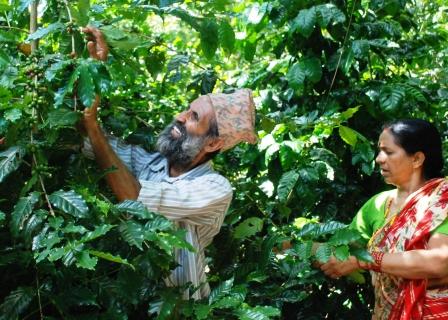Blog Biodiversity: a key player in the International Year of Family Farming

In her first blog post of 2014, M. Ann Tutwiler highlights the International Year of Family Farming and the vital role smallholder farmers play in food security, poverty eradication, natural resource management, and sustainable development.
The United Nations has designated 2014 as the International Year of Family Farming (IYFF), drawing significant attention in the policy arena to the role that family and smallholder farmers play in food security, poverty eradication, natural resource management, and sustainable development particularly in rural areas – and how to support them. After all, there are over 500 million family farms around the world, making up the predominant form of agriculture for food availability both in developed and developing countries.
In Africa, family farms make up 80% of all farms on the continent, and – much like Asia – small-scale farmers produce 80% of national food supply. Small-scale farmers are a mainstay of food security.
The IYFF squarely reflects Bioversity International’s mission to provide scientific evidence to shape decisions and actions to benefit smallholder farmers and rural communities living in poverty around the world.
Family farmers are intrinsically linked to their communities and landscapes, transmitting knowledge, skills, practices and technologies from generation to generation. They play a major role in the use and conservation of our natural resources, managing over 80% of the world’s arable land and 70% of the world’s water resources. Moreover, smallholder and family farmers are the custodians of biodiversity, a key asset for sustaining their livelihoods, particularly in marginal areas of the world. Smallholder farmers have relied on the evolutionary service of biodiversity for hundreds of years – in other words, allowing crops to evolve and adapt to changing environmental conditions, and diversifying them to reduce vulnerability.
Yet at the same time, over 70% of the world’s food insecure population lives in rural areas in developing countries. Many of them are subsistence producers who may not grow enough to meet their families’ needs. Smallholders lack the institutions and structures to manage their natural resource base, which is increasingly degraded and – given that most of these crops are also grown in rain-fed conditions – smallholder farms are particularly vulnerable to external shocks, including those induced by climate change.
The challenge ahead of us is complex. 842 million people in the world are currently food-insecure, a number that will only rise as weather variability induced by climate change takes its toll. Meanwhile, we must also boost food availability by 60% by 2050 to feed 9 billion mouths, both nutritiously and without further encroaching on our natural resource base.

In the financial world, when we face unmanageable and unpredictable risk, we are told to ‘’diversify, diversify and diversify’’. In light of the food security challenges that lie ahead, we need to put agricultural biodiversity to work as a tool to help family farmers cope and maintain food availability and crop production in the midst of risks posed by weather volatility, pests and diseases and natural disasters.
At Bioversity, we work directly with thousands of smallholder farmers to document, develop and deploy local biodiversity and associated knowledge to foster pro-poor, on-farm resilience.
The evidence speaks for itself on the critical role and potential of biodiversity in supporting smallholder farming. Not only is using diversity as a pest control method economically viable for smallholders, but it is also extremely effective: our trials with Ugandan banana farmers have seen a pest reduction of 75% by planting different varieties. Biodiversity plays a protective role in the event of extreme weather: after Hurricane Ike, diversified farms on Central American hillsides suffered losses of 50% compared to 90 or 100% in the neighboring monoculture farms.
Biodiversity reduces the likelihood of crop failure and shock, while maintaining or even increasing crop productivity: higher-diversity plots can be up to 70% more stable than monoculture and produce three times more biomass, ensuring and supporting the ecosystem services like pollination that support 75% of the world’s key crops.
But farmers and policymakers need clear, targeted solutions to integrate biodiversity into policy and practice. Here at Bioversity, we have launched the 'Bridging Agriculture and Conservation Initiative' - a new approach to agriculture in which farmers not only grow and raise more food, but are leading actors in the global conservation of our natural resources. It will collect and synthesize science to produce the evidence-based solutions to feed a growing population, while ensuring long-term conservation of biodiversity at national, regional and global levels.
I look forward to the progress this and other important initiatives will make in promoting and integrating biodiversity as a tool to boost food availability and sustain rural livelihoods sustainably and resiliently.
M. Ann Tutwiler
Email: M. Ann Tutwiler
Photo 1: Surya and Saraswati Adhikari on their model farm in Nepal where visitors from around the world come to find out how mixing agricultural biodiversity, the laws of nature and scientific knowledge can benefit their own farming practices. Credit: Bioversity International/B. Saugat
Photo 2: Custodian farmers from India presenting different varieties of millets. Credit: Bioversity International/S.Padulosi
